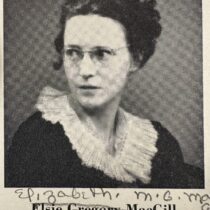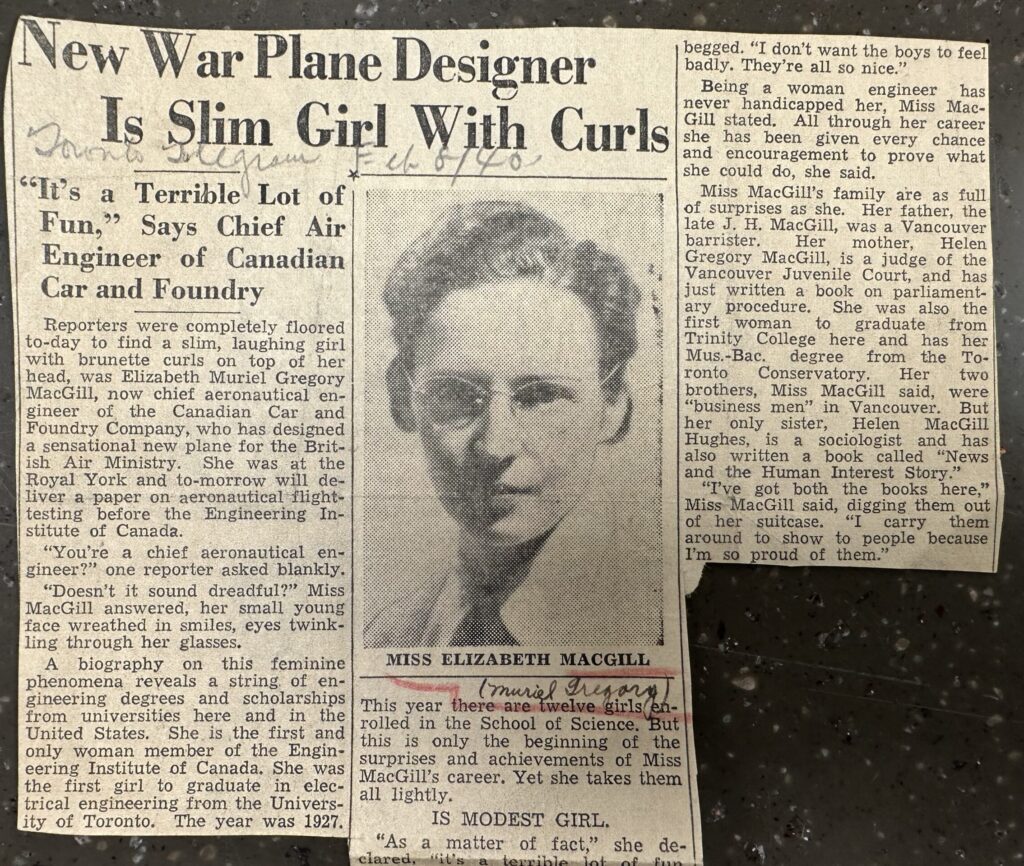Magazine

Altitude Problems
She was hailed as a World War II hero, but the primary sources surrounding Elsie MacGill reveal that her life and legacy were more complex and nuanced than the media would acknowledge.
By Madeleine Bradford
Newspapers described Elizabeth “Elsie” MacGill’s life as an inspiration.
She was the first woman to earn an aeronautical engineering master’s degree from U-M, in 1929. A polio survivor who learned to walk again using two canes, she was also a woman who became a chief engineer in a field full of men. She oversaw the manufacturing of so many Hurricane fighter planes in Canada during World War II that a comic was written about her, calling her the “Queen of the Hurricanes.”
When you open her alumni file at the Bentley Historical Library, it is full of newspaper clippings. Reporters seized on her life as a heroic tale of success despite the odds.
But this was only part of the story.
As “Queen of the Hurricanes,” Elsie was sensationalized for the Canadian war effort.
War industries badly needed women to work. Newspapers were hungry for heroes like Rosie the Riveter, splashed across pages to boost morale.
Elsie neatly fit the bill.
“Hurrah for Elsie!” People cheered in the background of the “Queen of the Hurricanes” comic. Recovering from polio in one panel, her speech bubble read:
“It’s good to be alive! Now I’m going to really start working!”
In reality, she told the Detroit News, her polio diagnosis had left her “despondent.” Most media glossed over the struggles she faced as someone who had trouble walking.
Being a figurehead, Elsie knew, also came with pressure to be perfect. She described it while discussing a Trainer plane that she helped design:
“When you first start to work on it, the men around the shop refer to the job quite impersonally as The Trainer. Then, just a few days before test flights begin, it suddenly becomes your Trainer, and it is implied that if anything goes wrong you know who’s to blame.”
Despite her expertise and successes, reporters still asked Elsie if she could cook.
She joked that her cakes had “altitude” problems.
Elsie insisted that she had “never noticed discrimination, if any existed, against her presence in a man’s field,” according to the 1940 Toronto Star.
She still spent much of her time dealing with bewildered reporters who didn’t expect a chief engineer to be a woman using canes.
Not a One-Man Job
Another strategy Elsie employed for dealing with the press was to redirect the spotlight.
“You really shouldn’t say the Maple Leaf was my job,” she told the Toronto Telegram in 1940 about the Maple Leaf Trainer plane. “Actually, it was the work of a number of people. Of course, if it had flopped, it would have been my responsibility.”
Elsie repeatedly insisted that “it isn’t a one-man job” to make airplanes, perhaps due in part to resentment in the factory.
“Reporters couldn’t see anybody but Elsie,” one of the women working at the Canadian Car and Foundry remarked, according to New Brunswick Professor David Frank, in his article “The Canadian Worker on Film.”
Elsie also deflected the spotlight by repeatedly bringing up her supportive family in interviews.

“I’m so proud of them,” she insisted, showing off books that her mother and sister had written, turning interviews about her life into interviews about her family.
Elsie herself would eventually write a book titled My Mother, The Judge.
In 1943, Elsie married E.J. Soulsby, a former plant manager from the Canadian Car and Foundry (known as CanCar), where Elsie worked.
Then, quite suddenly, she wasn’t working at CanCar anymore.
Ann Soulsby, Elsie’s stepdaughter, later alleged that Elsie had been fired. Given the stigma against working married women at the time, it’s possible her marriage may have been the reason.
However, in the marriage announcements in her alumni file, her war work is mentioned in each clipping; her job loss is not.
What these clippings do and don’t say underscores how media focus was still on Elsie’s heroic image, overshadowing the truth of her life.
After the War
As men returned from war, and manufacturing needs decreased, women found themselves losing the jobs they had just gained. Elsie’s reputation allowed her to visibly push for women’s rights, and she was appointed to the Royal Commission on the Status of Women in Canada, as well as joining several women’s organizations.
Her voice still wasn’t entirely heard.
In fact, she found herself having to file many of her personal suggestions alongside the commission’s report, rather than having them in the report itself. Her heroic reputation had been accepted onto the commission; her ideas about education, independence, and abortion were not.
Ultimately, no matter how hard she tried, Elsie couldn’t fully reshape her reputation; even today, when you search for Elsie MacGill’s name online, the title “Queen of the Hurricanes” follows closely behind.
The heroized version of her war work largely eclipses her later work in support of women’s rights, which is often mentioned secondarily, as well as shadowing her desire to share the spotlight with others.
More on Elsie’s life can be found in her alumni file, the Michigan Daily Digital Archives, and the Michigan Alumnus archives.
